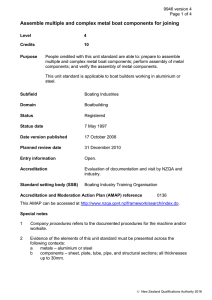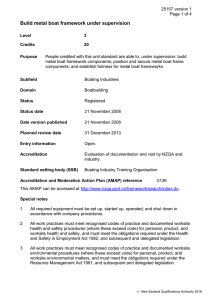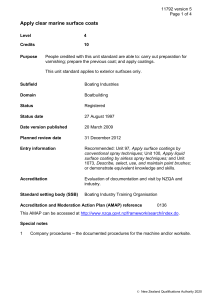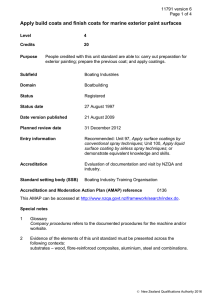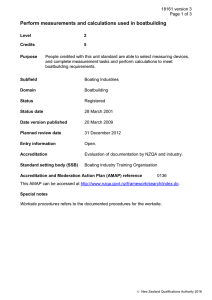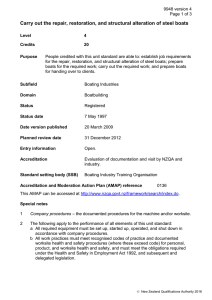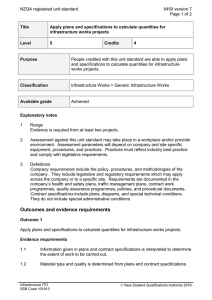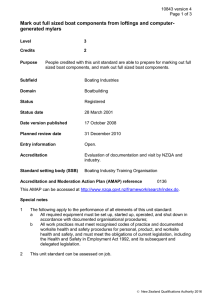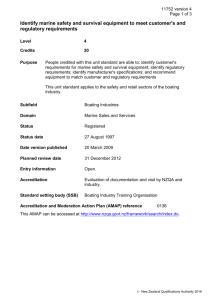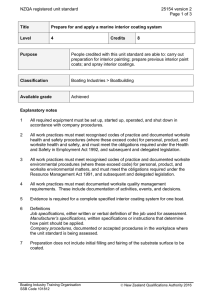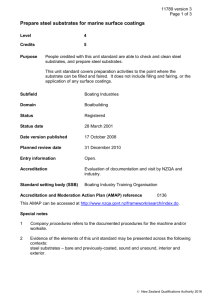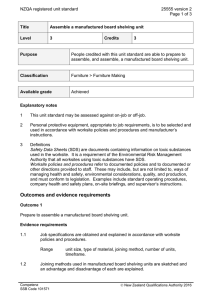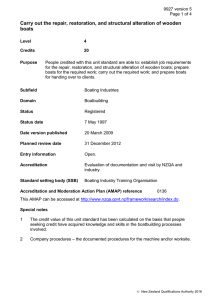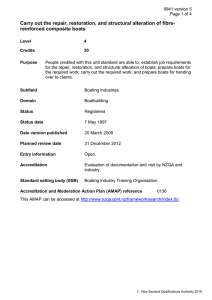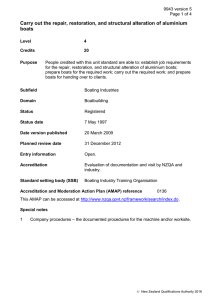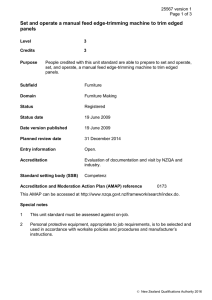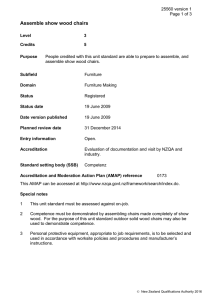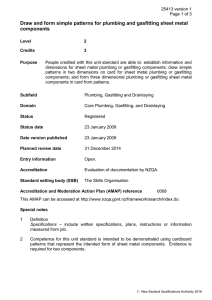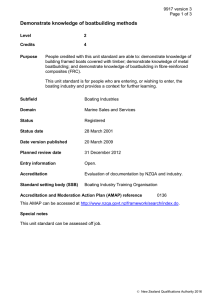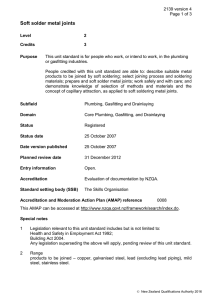Assemble metal components for joining in production boatbuilding under supervision
advertisement
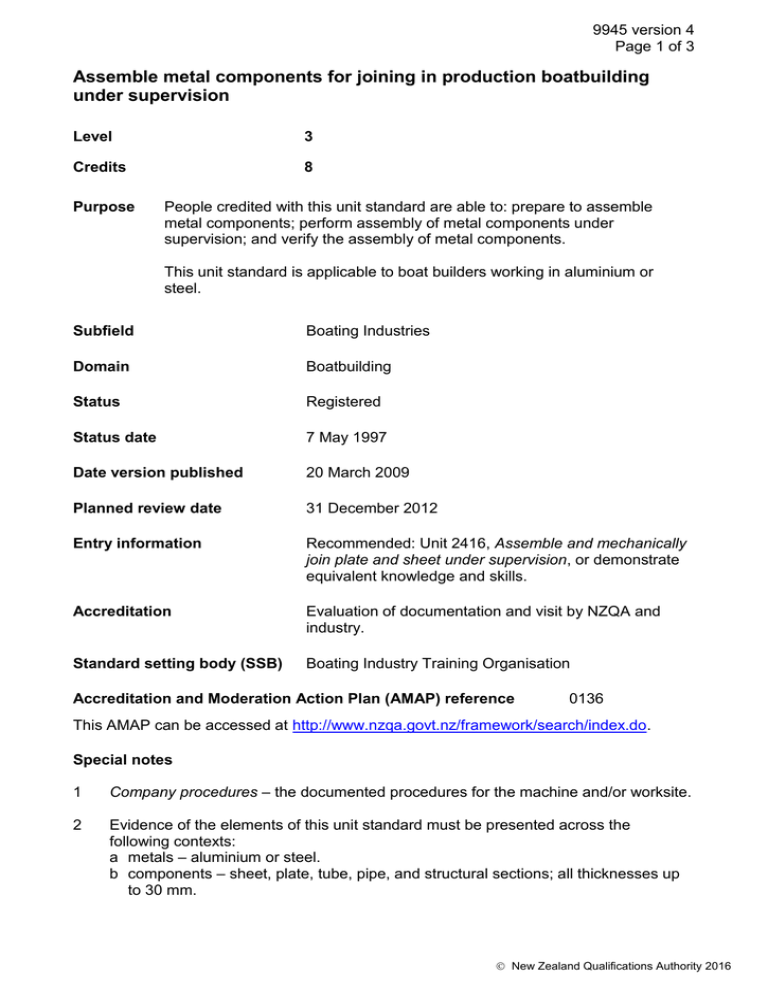
9945 version 4 Page 1 of 3 Assemble metal components for joining in production boatbuilding under supervision Level 3 Credits 8 Purpose People credited with this unit standard are able to: prepare to assemble metal components; perform assembly of metal components under supervision; and verify the assembly of metal components. This unit standard is applicable to boat builders working in aluminium or steel. Subfield Boating Industries Domain Boatbuilding Status Registered Status date 7 May 1997 Date version published 20 March 2009 Planned review date 31 December 2012 Entry information Recommended: Unit 2416, Assemble and mechanically join plate and sheet under supervision, or demonstrate equivalent knowledge and skills. Accreditation Evaluation of documentation and visit by NZQA and industry. Standard setting body (SSB) Boating Industry Training Organisation Accreditation and Moderation Action Plan (AMAP) reference 0136 This AMAP can be accessed at http://www.nzqa.govt.nz/framework/search/index.do. Special notes 1 Company procedures – the documented procedures for the machine and/or worksite. 2 Evidence of the elements of this unit standard must be presented across the following contexts: a metals – aluminium or steel. b components – sheet, plate, tube, pipe, and structural sections; all thicknesses up to 30 mm. New Zealand Qualifications Authority 2016 9945 version 4 Page 2 of 3 3 The following apply to the performance of all elements of this unit standard: a All required equipment must be set up, started up, operated, and shut down in accordance with company procedures. b All work practices must meet recognised codes of practice and documented worksite health and safety procedures (where these exceed code) for personal, product, and worksite health and safety, and must meet the obligations required under the Health and Safety in Employment Act 1992, and subsequent and delegated legislation. 4 This unit standard can be assessed on job. Elements and performance criteria Element 1 Prepare to assemble metal components. Performance criteria 1.1 Metal components are identified to job specifications. 1.2 Assembly methods are identified to ensure compliance with job specifications. 1.3 Tools and equipment for assembly are identified to job specifications. 1.4 Joint preparations are identified to job specifications. 1.5 Potential hazards are identified, and preventative action is taken in accordance with company procedures. 1.6 Assembly preparation is confirmed in accordance with company procedures. Element 2 Perform assembly of metal components under supervision. Performance criteria 2.1 Metal components are assembled to job specifications. 2.2 Datum points and lines are used to aid assembly in accordance with company procedures. 2.3 Jigs and fixtures are used to ensure assembly to job specifications. 2.4 Assembly problems and potential joining problems are identified and reported in accordance with company procedures. New Zealand Qualifications Authority 2016 9945 version 4 Page 3 of 3 Element 3 Verify the assembly of metal components. Performance criteria 3.1 Assemblies are inspected and measured in accordance with job specifications and company procedures. 3.2 Non-conformance is identified and reported in accordance with company procedures. Please note Providers must be accredited by NZQA, or an inter-institutional body with delegated authority for quality assurance, before they can report credits from assessment against unit standards or deliver courses of study leading to that assessment. Industry Training Organisations must be accredited by NZQA before they can register credits from assessment against unit standards. Accredited providers and Industry Training Organisations assessing against unit standards must engage with the moderation system that applies to those standards. Accreditation requirements and an outline of the moderation system that applies to this standard are outlined in the Accreditation and Moderation Action Plan (AMAP). The AMAP also includes useful information about special requirements for organisations wishing to develop education and training programmes, such as minimum qualifications for tutors and assessors, and special resource requirements. Comments on this unit standard Please contact the Boating Industry Training Organisation training@bia.org.nz if you wish to suggest changes to the content of this unit standard. New Zealand Qualifications Authority 2016
